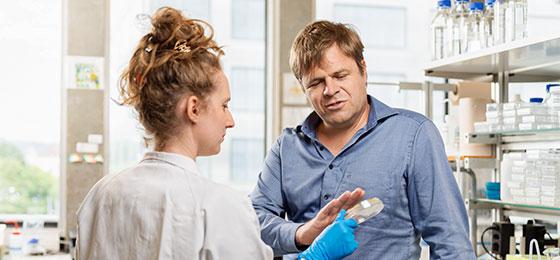Novel antibiotic deceives bacteria through mimicry

Most antibiotics need to penetrate their target bacteria. But Darobactin, a newly discovered compound, is much too large to do so. Nonetheless, it kills many antibiotic-resistant pathogens – by exploiting a tiny weak spot on their surface. Basel researchers have now revealed the amazing mechanism at play and thereby opened the door to developing completely new medicines.
An increasing number of bacterial pathogens are resistant to antibiotics. And the most dangerous pathogens share a common feature: a double membrane that is difficult to penetrate. Even when antibiotic agents are able to break into this shell, the bacteria just pump them right out again. But a recently discovered compound called Darobactin manages to circumvent these protective measures and kill nearly all problem pathogens. Researchers have now been able to elucidate the mechanism of action in a project funded by the Swiss National Science Foundation (SNSF) under the National Research Programme “Antimicrobial Resistance” (NRP 72).
Like a broken key
In a study published in Nature*, the researchers describe how a deceptive manoeuvre enables Darobactin to work: its shape mimics a special three-dimensional structure normally found only in proteins produced by bacteria as building blocks for their outer membrane. The structure is the “key” for inserting the proteins into the outer shell at specific locations. Darobactin is a copy of this key. However, it does not act to penetrate the bacteria, but merely blocks the keyhole from the outside – like locking a door and then breaking off the key. As a result, the transport route for the bacteria’s shell components is obstructed and they die.
Hard to detect by conventional means
Similar mechanisms are already known in microbiology and are used by other drugs. The targeted binding structures, or keyholes, are usually quite large – at least in microbiological terms. In contrast, the target inhibited by Darobactin is very small and cannot be detected by conventional methods. At the same time, Darobactin is larger than most drugs and cannot get through the entry ports of the bacteria.
“At the beginning, we were puzzled by this,” say Sebastian Hiller and Timm Maier of the Biozentrum of the University of Basel, the two principal authors of the study. Their teams immediately realised that Darobactin does not act inside the pathogens but rather on the surface. There it interferes with the function of a protein known as BamA, which plays a central role in the construction of the double-protective membrane. “But how exactly Darobactin interacts with BamA was completely unclear,” says Hiller. It was only by combining several methods that the researchers finally identified the mechanism of action.
Spotting the perfect weak point
They discovered that Darobactin attacks a true Achilles heel of the pathogens: it binds directly to the most important site of BamA, the so-called backbone atoms. Because these atoms hold the protein together and determine its shape, it is nearly impossible to change them – though changing them would be the usual way for the bacteria to fend off a new antibiotic. In fact, Darobactin retained its effectiveness against all pathogens, for which Hiller and his team conducted laboratory tests that simulate resistance. In other words, the pathogens failed to change the broken lock.
Targeted drug development
These findings are a decisive step towards medical application, says infection biologist Dirk Bumann, who also conducts research at the Biozentrum in Basel. As co-director of the National Centre of Competence in Research (NCCR) “AntiResist”, which like NRP 72 is funded by the SNSF, he closely follows activities in antibiotics research. “Identifying Darobactin’s mechanism of action is a major achievement,” he says, “because it will enable further targeted improvement of Darobactin and its development into an effective drug”. That gives a boost to the long-cherished hope of finding a new generation of antibiotics to fight many of today’s problem pathogens.
(*) Hundeep Kaur, Roman P Jakob et al.: The antibiotic darobactin mimics a β-strand to inhibit outer membrane insertase. Nature (2021).Doi 10.1038/s41586-
-w
Contact
National Research Programme “Antimicrobial Resistance” (NRP 72)
All over the world, more and more pathogens are becoming resistant to today’s antibiotics. Because medicines are losing their effectiveness, once easy-to-treat infections are turning into deadly diseases. The National Research Programme “Antimicrobial Resistance” (NRP 72) investigates possible counteractions to this development.
In view of the mobility of resistant bacteria between humans, animals and the environment, the NRP is pursuing a holistic, interdisciplinary one-health approach.
The main objectives of NRP 72 are:
- Increasing knowledge about resistance development and transmission mechanisms in order to interrupt these processes.
- Developing rapid diagnostic techniques and discovery of novel antimicrobial molecules to improve the treatment of humans and animals.
- Proposing recommendations and intervention measures for human and veterinary medical practitioners and farmers for more targeted use of antibiotics.
The NRP has a budget of 20 million Swiss francs for five years of research.
Links
- Images for editorial use:Image 1: (TIFF)Legend: Sebastian Hiller, professor at the Biozentrum of the University of Basel, and his team clarified the amazing mechanism of action of the antibiotic darobactin. ©NRP 72, Nadine Kägi
- Image 2: (TIFF)Legend: Two Petri dishes with bacterial cultures. In the right one, the addition of Darobactin has destroyed all bacteria, while in the control on the left they are still clearly visible as bright colonies. ©NRP 72, Nadine Kägi
- NFP-Projekt: The molecular mechanism of outer membrane protein insertion by BamA and its role as a target for novel antibiotics”
- Project in P3, the SNSF grant database
- National Centre of Competence in Research (NCCR) AntiResist